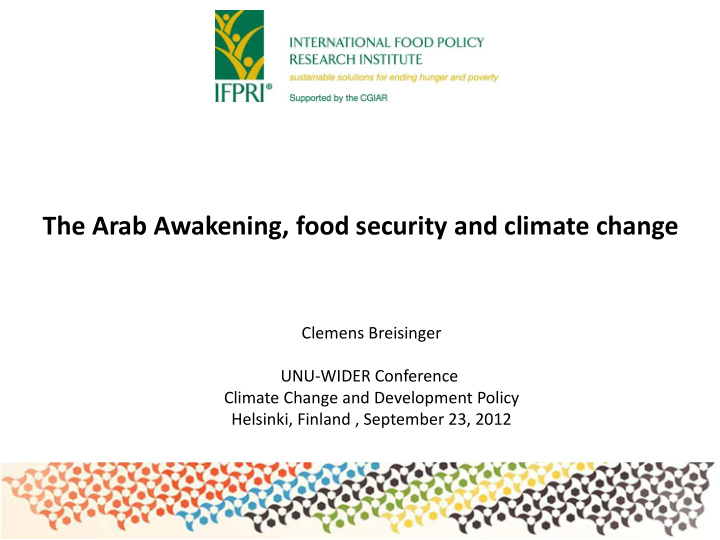



The Arab Awakening, food security and climate change Clemens Breisinger UNU-WIDER Conference Climate Change and Development Policy Helsinki, Finland , September 23, 2012
Overview
Arab Awakening a surprise? Social indicators are likely worse than suggested by official sources 1. Is growth in Arab countries really more pro-poor than elsewhere? 2. GINI coefficients: Is Egypt really among the top 20 most equal societies, ahead of Switzerland and Canada?
Gallup data suggests a worsening economic situation since 2005, suggesting that economics did play a role (among other factors) Percentage of people dissatisfied with their standard of living Yemen Iraq Lebanon Mauritania Morocco Syria Bahrain Sudan Libya Algeria Jordan Djibouti Saudi Arabia Tunisia Egypt UAE Kuwait Qatar GDP per capita (PPP, current international $) Source: Breisinger et al. 2012. Based on Gallup World Poll (2011) and WEO (2011) data. http://www.ifpri.org/sites/default/files/publications/bp018.pdf Note: Bubble size: Number of dissatisfied people. Color scale: Change in level of dissatisfaction (time period between first and last surveys undertaken in the country; last survey: 2010, first survey: 2005-2009): green: decrease; orange and red: increase, with red: increase at an annual growth rate of at least 2 percentage points.
Food security emerges as a key factor for stability and successful transition in the Arab world Regression (2) (4) (6) (8) • History shows that transition Dependent variable Incidence of major intra-state conflicts Model FE2SLS periods are risky, but provide 0.003 -0.0099*** -0.005*** -0.005*** Peace duration opportunity for change [0.006] [0.003] [0.002] [0.002] 0.196 -0.312 -0.178 -0.184 GDP growth (t-1) • Collier and Hoeffler find [0.213] [0.283] [0.163] [0.195] 0.0420*** Child stunting economic growth as a key [0.016] determinant of conflict globally 0.011*** Child mortality [0.004] • In the Arab world, we find that 0.011*** Macro Food [0.004] Insecurity food security emerges as the 0.013** Macro Food main cause of conflicts [0.006] Insecurity incl. remittances • A price-induced change in child incl. incl. incl. incl. Country Fixed Effects incl. incl. incl. incl. Time dummies stunting, mortality rate, and the 433 246 685 685 Observations macro food security index 22 22 22 22 Number of countries 2.731** 4.603*** 5.335*** 4.484*** F-test increases the risk of conflict by 15.23*** 13.76*** 17.14*** 8.819** Underid test 10.2, 11.0 and 0.04 percentage 0.52 0.24 0.66 0.46 P-value Hansen test 10.83*** 6.85*** 7.74*** 3.99** F-test on excl. IV points. 0.25 0.26 0.24 0.26 Root MSE Maystadt et al. 2012: http://www.ifpri.org/publication/does-food- security-matter-transition-arab-countries
Food security framework http://www.ifpri.org/sites/default/files/publications/ifpridp01166.pdf
Arab macro food insecurity Source: Breisinger C., O. Ecker, P. Al-Riffai and B. Yu. 2012. Beyond the Arab Awakening: Policies and Investments for Poverty Reduction and Food Security . IFPRI Food Policy Report. Washington, DC: International Food Policy Research Institute.
Arab micro food insecurity Source: Breisinger C., O. Ecker, P. Al-Riffai and B. Yu. 2012. Beyond the Arab Awakening: Policies and Investments for Poverty Reduction and Food Security . IFPRI Food Policy Report. Washington, DC: International Food Policy Research Institute.
Food security and climate change impact channels Bio-physical impacts: More frequent droughts/floods Sea level rise Infrastructure Reductions in agricultural yields Economic impacts: Changing food and energy prices Changes in GDP and household incomes Fiscal impact
See http://www.ifpri.org/climatechange/casemaps.html GCM temperature results vary as well monthly maximum temp change scenarios, MIROC and CSIRO GCMs 2000 2000-2030 change, CSIRO 2000-2030 change, MIROC A1B A1B 2000-2080 change Page 10
Climate change is projected to reduce yields in Arab countries (examples Syria, Tunisia, Yemen) Climate change induced yield changes (MIROC, 2010- 2050) • Yields for most crops 0.00 Tunisia Yemen Syria are projected to -0.20 decline, mainly due to Average annual yield change (%) changes in -0.40 temperature and -0.60 rainfall patterns • Both rain-fed and -0.80 irrigated agriculture -1.00 are likely to suffer Wheat (irrigated) Wheat (rainfed) -1.20 Source: Breisinger et al. 2011 and Wiebelt 2011
Climate change is projected to increase global food prices Price increase (%), 2010 – 2050, Baseline economy and demography • Maize price mean increase is 101% • Rice price mean increase is 55%; • Wheat price mean increase is 54%. Source: Nelson et al. 2011
A comprehensive modeling framework is needed to bring biophysical and economic dimensions together IFPRI-IMPACT Model and Energy Information Administration DCGE Model * Macro-economy * Agriculture and other sectors *Households DSSAT crop modeling Long term Yield changes Global climate model (GCM) downscaled and historical meteorological data
CGE model results: global and local impacts on households depend on net food consumption position (examples Syria, Tunisia, Yemen) Source: Breisinger et al. 2011, Wiebelt et al. 2011
Key messages • There is an urgent need for improving data quality and access • Economics played a role in the Arab Awakening • Improving food security will be critical for successful transition • Climate change in Arab countries will be felt through global food price changes
Closing data gaps and promoting food security: an Arab food security Atlas IFRPI with support from IFAD
The Atlas is GIS based and the interface is very user-friendly
So far, the Atlas includes about 150+ variables, for example population density…
…migration patterns…
…infrastructure – travel time…
Some of IFPRI’s products on the Arab World IFPRI MENA Website: http://www.ifpri.org/book-6959/ourwork/researcharea/middle-east-and-north-africa We acknowledge financial support from the EU, GIZ, IFAD, and the World Bank.
Recommend
More recommend